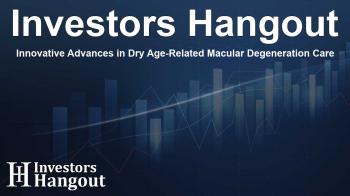Innovative Advances in Dry Age-Related Macular Degeneration Care

Understanding Dry Age-Related Macular Degeneration
Dry age-related macular degeneration (AMD) is a prevalent eye condition affecting individuals over 50. It leads to distinct symptoms, including blurred or diminished central vision, primarily due to the thinning of the macula, which is crucial for clear sight. The pharmaceutical sector is showing increasing interest in developing effective treatments targeting dry AMD, focusing on pathway-based therapies. Treatments under evaluation, such as ALK-001 and LBS-008, along with new combination approaches, might be essential in halting disease progression.
Active Players in the Dry AMD Treatment Sphere
The landscape of dry AMD treatment is vibrant and burgeoning, with over 70 active companies immersed in developing more than 80 pipeline therapies aimed at addressing this condition. Notable players include Alkeus Pharmaceuticals, Dobecure, Belite Bio, Cognition Therapeutics, Aviceda Therapeutics, Stealth BioTherapeutics, and many others. These organizations are dedicated to advancing the treatment landscape for dry AMD, fostering hope for many individuals affected by this debilitating condition.
Recent Clinical Developments
The development timelines of these therapies tell the story of innovation. For instance, in December 2024, Galimedix Therapeutics initiated its Phase II eDREAM study, evaluating the safety and efficacy of GAL-101 eye drops, while Ocugen, Inc. made headlines with its promising results for the OCU410 ArMaDa trial, focusing on geographic atrophy secondary to dry AMD. As companies like Eyestem Research and Stealth BioTherapeutics unveil positive trial results, the momentum in this space is palpable, raising hopes for effective treatments.
The Emerging Drug Pipeline
As the development of therapies for dry AMD continues to evolve, a robust pipeline supports these efforts. The ongoing clinical trials include numerous promising candidates, such as ALK-001 and Tinlarebant (LBS-008), which show potential in different phases of testing. Continuous progress in this pipeline not only illustrates the dedication of researchers and companies involved but also highlights the prospect of new options for patients who currently have limited or no approved treatments available.
Technology in Monitoring and Treatment
Additionally, advancements in imaging technologies significantly contribute to early detection and monitoring of dry AMD. Various techniques like optical coherence tomography (OCT) allow clinicians to detect early signs of the condition. Enhanced imaging capabilities are essential tools in assessing the effectiveness of emerging therapies, ensuring that patients receive timely interventions.
Supporting the Patient Journey
While no treatments are yet approved specifically for dry AMD, managing the condition through regular monitoring, detection, and appropriate interventions is vital. Research continues to explore various therapeutic strategies to either prevent the onset of AMD or to slow its progression. Potential avenues of treatment are being explored in areas such as gene therapy, visual cycle modulators, and complement inhibitors.
Future Perspectives for Dry AMD Therapy
The future holds promise as continued research and development progresses in the dry AMD therapeutic landscape. Systematic assessments of both products currently in trials and the strategies employed by leading companies will impact not just the growth of available treatment options but also help fulfill the significant unmet medical needs of those afflicted by this condition.
Frequently Asked Questions
1. What is dry age-related macular degeneration?
Dry age-related macular degeneration is an eye disorder associated with aging, causing gradual vision loss due to the deterioration of the macula.
2. How common is dry AMD among older adults?
Dry AMD is one of the leading causes of vision impairment in older adults, affecting millions globally.
3. Are there any approved treatments for dry AMD?
Currently, there are no approved treatments specifically for dry AMD, with management focusing on monitoring and symptom management.
4. What advancements are being made in the treatment of dry AMD?
Over 70 companies are engaged in developing new therapies aimed at addressing dry AMD, with numerous clinical trials underway.
5. How do imaging technologies aid in the management of dry AMD?
Imaging technologies like optical coherence tomography (OCT) help in early detection, monitoring disease progression, and assessing treatment efficacy.
About Investors Hangout
Investors Hangout is a leading online stock forum for financial discussion and learning, offering a wide range of free tools and resources. It draws in traders of all levels, who exchange market knowledge, investigate trading tactics, and keep an eye on industry developments in real time. Featuring financial articles, stock message boards, quotes, charts, company profiles, and live news updates. Through cooperative learning and a wealth of informational resources, it helps users from novices creating their first portfolios to experts honing their techniques. Join Investors Hangout today: https://investorshangout.com/
Disclaimer: The content of this article is solely for general informational purposes only; it does not represent legal, financial, or investment advice. Investors Hangout does not offer financial advice; the author is not a licensed financial advisor. Consult a qualified advisor before making any financial or investment decisions based on this article. The author's interpretation of publicly available data presented here; as a result, they should not be taken as advice to purchase, sell, or hold any securities mentioned or any other investments. If any of the material offered here is inaccurate, please contact us for corrections.
